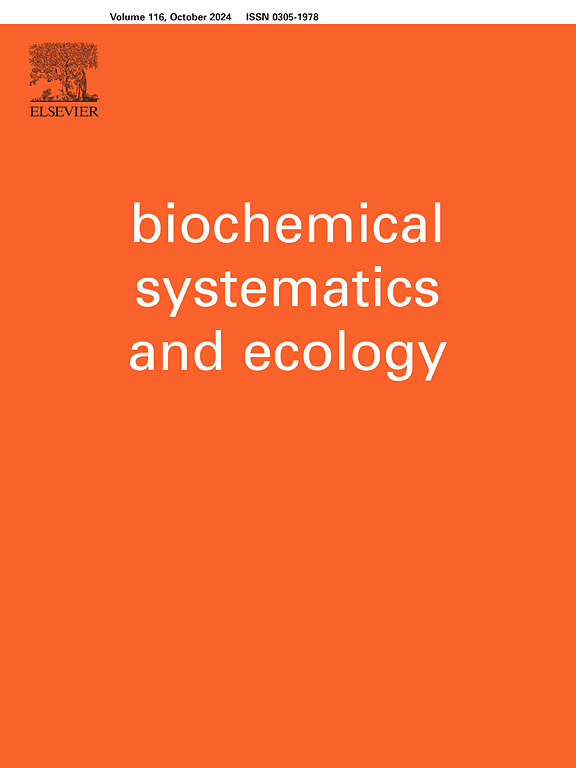Chemical constituents from the flowers of Inula japonica: Chemotaxonomic significance and antidiabetic activity
IF 2
4区 生物学
Q4 BIOCHEMISTRY & MOLECULAR BIOLOGY
引用次数: 0
Abstract
Phytochemical investigation on the flowers of Inula japonica Thunb. (Asteraceae) resulted in the isolation and characterization of twenty-four compounds, including five pseudo guaiane-type sesquiterpene lactones (1–5), three xanthane-type sesquiterpene lactones (6–8), three ionone-type sesquiterpenoid derivatives (9–11), one drimane-type sesquiterpenoid dimer (12), two triterpenoids (13,14), eight phenolic compounds (15–22), and two steroids (23,24). Their structures were identified by spectroscopic analyses and comparison with literature data. Among them, four compounds (11, 12, 13, and 22) were identified for the first time from the genus Inula, and seven compounds (7, 9, 17, 19, 20, 21, and 24) were reported for the first time from I. japonica. The chemotaxonomic significance of these compounds was discussed. Furthermore, the antidiabetic activities of the eight sesquiterpene lactones (1–8) were evaluated using a glucose uptake assay in C2C12 myotubes, and compound 7 significantly increased glucose uptake at a concentration of 20 μM, comparable to the effect of the positive control metformin (2 mM).

日本菊花的化学成分:化学分类意义和抗糖尿病活性
日本菊花的植物化学研究。从该植物中分离鉴定出24个化合物,包括5个假愈疮烷型倍半萜内酯(1-5)、3个黄烷型倍半萜内酯(6-8)、3个离子型倍半萜衍生物(9-11)、1个驱虫烷型倍半萜二聚体(12)、2个三萜(13,14)、8个酚类化合物(15-22)和2个甾体(23,24)。通过光谱分析和文献资料对比,鉴定了它们的结构。其中化合物11、12、13、22为首次从鸢尾属植物中分离得到,7个化合物7、9、17、19、20、21、24为首次从鸢尾属植物中分离得到。讨论了这些化合物的化学分类意义。此外,通过C2C12肌管葡萄糖摄取实验评估了8种倍半萜内酯(1-8)的抗糖尿病活性,化合物7在浓度为20 μM时显著增加葡萄糖摄取,与阳性对照二甲双胍(2 mM)的效果相当。
本文章由计算机程序翻译,如有差异,请以英文原文为准。
求助全文
约1分钟内获得全文
求助全文
来源期刊

Biochemical Systematics and Ecology
生物-进化生物学
CiteScore
3.00
自引率
12.50%
发文量
147
审稿时长
43 days
期刊介绍:
Biochemical Systematics and Ecology is devoted to the publication of original papers and reviews, both submitted and invited, in two subject areas: I) the application of biochemistry to problems relating to systematic biology of organisms (biochemical systematics); II) the role of biochemistry in interactions between organisms or between an organism and its environment (biochemical ecology).
In the Biochemical Systematics subject area, comparative studies of the distribution of (secondary) metabolites within a wider taxon (e.g. genus or family) are welcome. Comparative studies, encompassing multiple accessions of each of the taxa within their distribution are particularly encouraged. Welcome are also studies combining classical chemosystematic studies (such as comparative HPLC-MS or GC-MS investigations) with (macro-) molecular phylogenetic studies. Studies that involve the comparative use of compounds to help differentiate among species such as adulterants or substitutes that illustrate the applied use of chemosystematics are welcome. In contrast, studies solely employing macromolecular phylogenetic techniques (gene sequences, RAPD studies etc.) will be considered out of scope. Discouraged are manuscripts that report known or new compounds from a single source taxon without addressing a systematic hypothesis. Also considered out of scope are studies using outdated and hard to reproduce macromolecular techniques such as RAPDs in combination with standard chemosystematic techniques such as GC-FID and GC-MS.
 求助内容:
求助内容: 应助结果提醒方式:
应助结果提醒方式:


